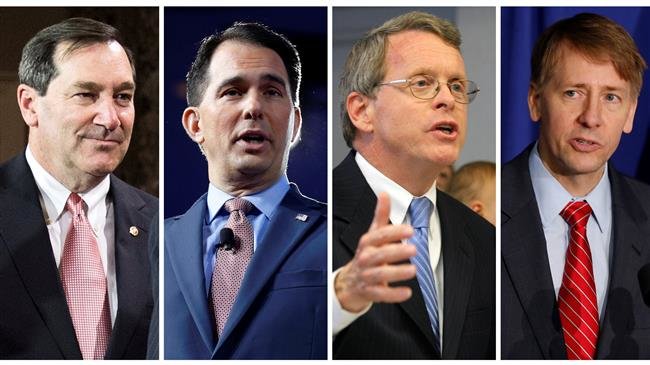US: Democrats have leads in Rust Belt states that Trump won
An Indiana US Senator seen as one of the chamber’s most vulnerable Democrats has a slight edge while four of his Rust Belt Democratic colleagues have solid leads in states President Donald Trump won in 2016, a Reuters poll found.
A Reuters/Ipsos/UVA Center for Politics Poll released on Wednesday found that a majority of likely voters in Pennsylvania, Wisconsin, Ohio, Michigan and Indiana disapprove of the Republican president and more than one-third were “very motivated” to back someone who would oppose his policies.
The poll found that Senator Joe Donnelly of Indiana has a 3 percentage point lead among likely voters over Republican businessman Mike Braun. Braun, a former state representative, has positioned himself as a Trump-like candidate who would bring an outsider’s perspective to politics in Vice President Mike Pence’s home state.
Democrats are aiming to win two more Senate seats in the Nov. 6 congressional election to take a majority in that chamber and serve as a check on Trump’s agenda. They can ill afford to lose any of the five seats covered by the poll.
Trump won the five states after pitching himself as a business-savvy pragmatist who would improve the lives of working class Americans. Two years later, more than half of likely voters in those states think the country is now on the “wrong track,” the poll found.
“There are lots of places in this region where economic opportunity has been stifled,” said Kyle Kondik, a political analyst at the Center for Politics.
Kondik said the Rust Belt frequently shifts its support between parties, in some cases because voters who are frustrated with the lack of economic progress come to the ballot box intent on checking the party in power.
This year Democrats have the added advantage of being able to attack an unpopular president as well as Republicans’ deficit-increasing tax plan and their failed effort to dismantle the Affordable Care Act, better known as Obamacare, he said.
The state polls were conducted online, in English, from Sept. 12 to Sept. 21. They surveyed between 1,074 and 1,181 likely voters in each of five states and weighted the responses according to the latest government population estimates.
The polls each have a credibility interval, a measure of precision, of about 3 percentage points, meaning the results could vary in either direction by that much.
The results measured how voters felt at the time of the survey. Those feelings may change: In 2016, one in eight Americans said they made their presidential pick in the week before Election Day, according to a Reuters/Ipsos poll.
Blue wave in Wisconsin?
The wave of support for Democrats may unseat Wisconsin Governor Scott Walker, a Republican former presidential candidate who became popular in conservative circles for taking on unions.
Walker trailed Democratic state schools superintendent Tony Evers by 7 percentage points.
In the Ohio governor’s race, Republican Mike DeWine fared better. DeWine, the state’s attorney general, held a 1 point edge over Democrat Richard Cordray, who is also seeking to succeed Governor John Kasich, a Trump critic.
Elsewhere, the poll found Democratic candidates on solid footing.
In Pennsylvania, US Senator Bob Casey Jr., a Democrat, led Republican congressman Lou Barletta by 16 points, and in the governor’s race incumbent Democrat Tom Wolf was ahead of Republican Scott Wagner by 17 points.
In Michigan, US Senator Debbie Stabenow, a Democrat, led Republican challenger John James by 20 points, while Democrat Gretchen Whitmer was ahead of Republican Bill Schuette by 13 points in the governor’s race.
In Ohio, incumbent US Senator Sherrod Brown led Republican Jim Renacci by 11 points.
(Source: Reuters)





